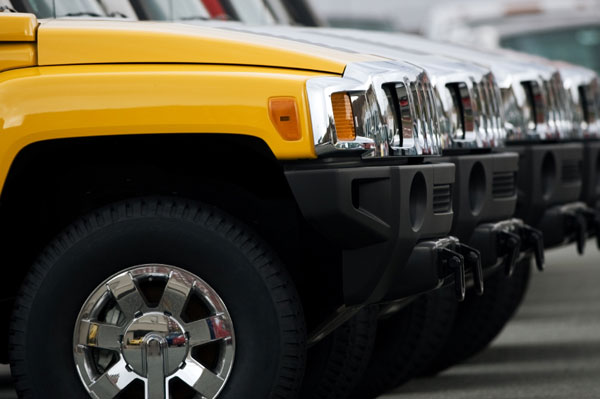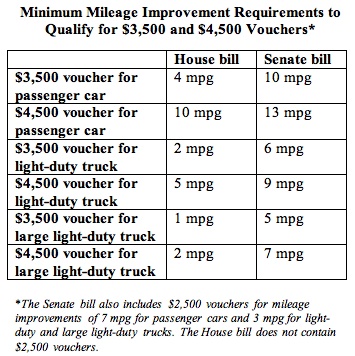Cash to Trade Clunkers for Clunkers?
New vehicles that get one or two miles per gallon better, qualify drivers for a $4,500 cash credit.
Jul 31, 202016.1K Shares647.6K Views
On its surface, it sounds like a wonderful environmental benefit: A program providing thousands of dollars to drivers who scrap their gas guzzlers in favor of more fuel-efficient models. Yet critics on and off Capitol Hill say the so-called “cash-for-clunkers” initiative has morphed into a billion-dollar industry handout, allowing automakers to push large, inefficient and otherwise unsellable vehicles off of bursting lots, in the process undermining separate efforts to reduce the nation’s carbon emissions.
Several different cash-for-clunkers’ proposals have surfaced in Congress this year, but the version currently making its way toward the president’s desk — championed by Rep. Betty Sutton (D-Ohio) and Sen. Debbie Stabenow (D-Mich.) — offers cash vouchers up to $4,500 for drivers who swap their gas-slurping cars, trucks and SUVs for vehicles boasting better fuel economies. Supporters of the proposal consider it a multi-pronged benefit, offering consumers big rebates in a down economy, stimulating car sales to help struggling automakers and dealers, and yanking clunkers off the roads for the benefit of the environment.
Illustration by: Matt Mahurin
Yet critics are quick to point out that the bill offers discounts on many new vehicles with fuel economies below the average even within their own vehicle class. As a result, some truck and SUV drivers will be eligible for thousands of taxpayer dollars to purchase the latest version of the same large vehicle they’ve just scrapped — even in cases when the new model boasts just one- or two- miles-per-gallon better economy than the old. Many environmentalists, and some lawmakers, say the proposal is just another case of Congress protecting the auto industry — which has already received billions of dollars in federal help — at the expense of the environment.
In a Wall Street Journal op-ed published last week, Sens. Dianne Feinstein (D-Calif.) and Susan Collins (R-Maine) called the Sutton and Stabenow bills “another big bailout” for the industry. “These bills are expertly designed to provide Detroit one last windfall in selling off gas guzzlers currently sitting on dealer lots because they’re not a smart buy,” the lawmakers wrote.
The debate is emblematic of the conflicting responsibilities facing Democratic leaders trying simultaneously to pull the country out of a deep recession, tackle the specter of global warming and manage both in ways that can pass through a Congress prone to protecting regional industries. On one hand, Democrats are pushing new laws encouraging reductions in greenhouse emissions; on the other hand, they’ve already spent billions to help Detroit’s automakers, and don’t want to see the investment go to waste.
Indeed, Sutton’s $4 billion proposalwon strong bipartisan backing in the House last week, passing the lower chamberas a stand-alone bill by a count of 298 to 119, with 59 Republicans joining most Democrats in favor of the proposal. Though the Senate has no plans to take up the full $4 billion proposal in the near future, lawmakers on Friday attached a smaller, $1 billion version of the bill to must-pass spending legislation funding the wars in Iraq and Afghanistan. The House passed the spending packageTuesday night, with the Senate expected to take it up as early as this week.
Under the Sutton proposal, drivers of cars and small trucks getting no more than 18 mpg can trade them in for cash toward the purchase of new vehicles. If the new vehicle is a car boasting a mileage improvement of at least 4 mpg, the trade in will be worth $3,500. If the car is at least 10 mpg more efficient, the cash reward jumps to $4,500. For small trucks, SUVs and minivans, the new vehicle must get at least 18 mpg, with the $3,500 and $4,500 voucher going to vehicles at least 2 mpg and 5 mpg more efficient, respectively. For even larger pickups and SUVs, the minimum economy for the new vehicle is 15 mpg, with an improvement of 1 mpg above the trade-in resulting in the $3,500 reward and an improvement of 2 mpg yielding $4,500. The old vehicles would be destroyed to get them off the roads forever.
“This legislation will ensure that we have a strong manufacturing base and get more fuel-efficient vehicles on the road, which is essential to our economy, to our national security, and a clean, green future,” House Speaker Nancy Pelosi said in a statement.
Yet under those guidelines, owners of 1996 4WD Ford F150 pickups (fuel efficiency of 14 mpg) could trade them in on 2009 4WD Ford F150 pickups (15 mpg), and receive $3,500 for the effort. The driver of a 1994 2WD Jeep Grand Cherokee (16 mpg) would be eligible for $3,500 with a trade-in on the 2009 version of the same vehicle (18 mpg). And consumers could trade their 1995 4WD Dodge Ram pickups (13 mpg) for $4,500 toward a brand new 4WD Hummer HT3 (16 mpg). The list goes on.
Image has not been found. URL: /wp-content/uploads/2009/06/trade-ins2.jpg“Basically, you can trade in a clunker and get a voucher for a new clunker,” said Daniel Becker, director of the Safe Climate Campaign, which advocates for better fuel efficiency. “The auto guys are out there shaking their tin cup, and there are lawmakers who are happy to fill it up.”
Neither the offices of Stabenow nor Sutton returned requests for comment.
Environmentalists prefer a competing proposal, sponsored by Feinstein, Collins and Sen. Charles Schumer (D-N.Y.), that promotes a similar cash-incentive structure but increases the mileage improvement thresholds consumers must reach to receive vouchers. The bill also ups the fuel-efficiency floors in each vehicle category to coincide with the 2008 average economy in each vehicle class. As a result, the lawmakers estimate their bill would reduce greenhouse gas emissions and gasoline consumption per vehicle by 32 percent each year relative to the House bill.
“Our legislation is not aimed at bailing out the auto industry, although it would spur vehicle sales,” Collins said in a statement. “It is environmental legislation that has the added benefit of helping the auto industry.”
Yet many supporters of Sutton’s bill — both on and off Capitol Hill — contend that Collins has it backwards. Cash for Clunkers, they say, should prioritize economic stimulus, with the added benefit of helping the environment.
“This is not the House climate change bill,” said Stephen J. Collins, president of the Automotive Trade Policy Council, which represents Ford, Chrysler and General Motors. “That’s not its sole purpose.”
President Obama — who delighted environmentalists earlier this year by announcing the adoption of stricter national emissions standards— endorsed the Cash for Clunkers concept in March. During a speech on the future of the automotive industry, the president noted that similar programs adopted by a number of European countries have succeeded “in boosting auto sales.”
The emphasis on the economy above the environment in the cash-for-clunkers debate has alienated some consumer groups. Lena Pons, an auto policy analyst at Public Citizen, said the group was involved in early discussions surrounding the program, but dropped out of the negotiations when it become clear the industry defenders were poised to have their way.
“It looked like the priority was about moving vehicles off the dealer lots,” Pons said. “There were a lot of parties who were interested only in reducing the backlog of inventory.”

Hajra Shannon
Reviewer
Latest Articles
Popular Articles



